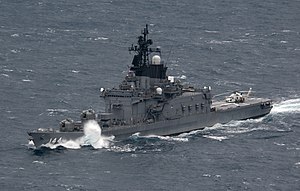Shirane-class destroyer
 Kurama (DDH-144) at sea in 2011 | |
| Class overview | |
|---|---|
| Name | Shirane-class destroyer |
| Builders | Ishikawajima-Harima, Tokyo |
| Operators |  Japan Maritime Self-Defense Force Japan Maritime Self-Defense Force |
| Preceded by | Haruna-class destroyer |
| Succeeded by | Hyūga-class helicopter destroyer |
| Built | 1977–1981 |
| In commission | 1980–2017 |
| Planned | 2 |
| Completed | 2 |
| Retired | 2 |
| General characteristics | |
| Type | Destroyer |
| Displacement |
|
| Length | 159 m (522 ft) |
| Beam | 17.5 m (57 ft 5 in) |
| Draft | 5.3 m (17 ft 5 in) |
| Propulsion |
|
| Speed | 31 knots (36 mph; 57 km/h) |
| Complement |
|
| Sensors and processing systems |
|
| Electronic warfare & decoys |
|
| Armament |
|
| Aircraft carried | 3 × SH-60J(K) anti-submarine helicopters |
The Shirane-class destroyers were a pair of Japanese destroyers originally built during the late 1970s. They are built around a large central hangar which houses up to three helicopters and they are the natural successor of the Haruna-class destroyers.
Design
The Shirane class incorporates an improved design based on the Haruna-class destroyers. The ships propulsion include two steam boilers with two shafts that produce 70.000 hp and gives a maximum speed of 32 knots.
Its armament includes two Mk.42 127mm guns, two 20-mm Phalanx close-in weapon systems, one surface-to-air RIM-7 Sea Sparrow launcher, torpedoes and anti-submarine rockets.[1] The ships has been replaced by the new Izumo-class helicopter destroyers.
Ships in the class
| Pennant no. | Name | Laid down | Launched | Commissioned | Decommissioned | Home port |
|---|---|---|---|---|---|---|
| DDH-143 | Shirane | 25 February 1977 | 18 September 1978 | 17 March 1980 | 25 March 2015 | Yokosuka |
| DDH-144 | Kurama | 17 February 1978 | 20 September 1979 | 27 March 1981 | 22 March 2017 | Sasebo |
Operational use
On December 15, 2007, a fire broke out on board Shirane near the rudder house as it was anchored at Yokosuka. It took seven hours to extinguish the fire, which injured four crew members.[2]
On 27 October 2009, JS Kurama collided with a South Korean container ship under the Kanmonkyo Bridge in the Kanmon Straits off the coast of Japan.[3] While neither ship sunk, the bow of Kurama was badly damaged and burned for hours. Three Kurama crew members were reported injured.[4]
References
- ^ "Shirane Class Helicopter Destroyers (JMSDF) - Naval Technology".
- ^ "Latest Stories". www.dawn.com. December 15, 2007. Retrieved 2010-08-14.
- ^ Mari Yamaguchi (2009-10-27). "World Naval Ships Forums - View Single Post - JDS Kurama (DDH-144) Collision". www.worldnavalships.com. Retrieved 2010-08-14.
- ^ "CBC News - World - Japanese destroyer collides with Korean ship". cbc.ca. 2009-10-27. Retrieved 2010-08-14.
External links

- GlobalSecurity.org; JMSDF DDH Shirane Class
- v
- t
- e
- Shirane
- Kurama
- Preceded by: Haruna class
- Followed by: Hyūga class
- List of destroyers of the Japan Maritime Self-Defense Force
 | This article about a specific military ship or boat of Japan is a stub. You can help Wikipedia by expanding it. |
- v
- t
- e












